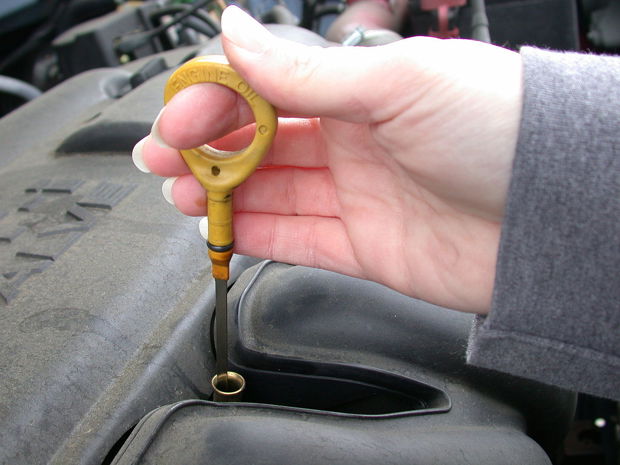Welcome to Stories of the Mechanically Declined! Every month, we highlight a story or situation that reinforces the need for drivers and shoppers to understand their vehicle, how to maintain it, and how it works.
You’re not planning to buy that vehicle, are you?
For what seemed like forever, changing your vehicle’s engine oil every 5,000 kilometres or so was the generally accepted practice. This was simple: drive 5,000 km, change the oil, repeat as needed.
Then, oil change things got a little blurry. Today, they’re often downright confusing.
Modern engines often have extended oil change intervals, possibly requiring an oil change on an as-needed basis, as per an oil-life monitor system that advises owners when an oil change is required after monitoring numerous factors. Other engines have fixed oil change intervals that stretch into the tens of thousands of kilometres.
This month, we’re looking at an video by YouTuber ImStricken06. In this 55-second clip, a technician takes us on a tour of the internals of the bottom end of a Mercedes engine that he’s taken apart. This engine appears to be the victim of extended oil change intervals gone wrong: the title of the video suggests that this engine may have had a 30,000-mile oil change interval prescribed, and the results speak for themselves.
The insides of this powerplant look less like an engine, and more like the bottom of a baking sheet after Aunt Maud incinerated the Thanksgiving roast.
Let’s Ask the Experts
Even if the oil change interval prescribed was as long as suggested, it’s unlikely that’s the whole story here. We asked some experts to weight in.
“You’re not planning to buy that vehicle, are you?” asks John Kennard, an automotive service technician from Mississauga, Ontario. “That’s a real mess, that engine!”
“In my experience, most customers are good about their oil changes and follow the instructions pretty well. I actually get a lot of customers in for servicing from our used car business asking if the car can really go, say, 15,000 kilometres before an oil change. I tell them it can, provided they use the right oil and filter. Should it? Depends, maybe, but I tell customers to make sure the oil is changed by that point, not a moment later.
“And if you cheap out at the lube shop and run regular oil (not synthetic) for that long, you might pay for it down the line.”

Automotive service advisor Lori Boerio agrees: “There’s something not right in this video.
“That’s a really long oil change interval. Maybe that’s a specialized commercial vehicle that’s been subjected to severe use. The oil is really broken down and that engine has probably suffered some serious damage. I’d be willing to bet it was improperly maintained, even filed with the wrong grade of oil. Maybe the filter was incorrect, too.
“We see a lot of customers who are apprehensive about extended oil change intervals and most seem weary. But if drivers specifically follow the instructions in the owner’s manual, and use the proper parts and oil, there’s little to worry about.
“A few months back, one customer called because they’d driven for over a year without an oil change, and asked if the oil change reminder message would come on soon. But their vehicle didn’t have an oil life monitor, so there was no reminder message. They were about 8,000 kilometres late for an oil change, in this case.”

Regular expert contributor Paul Kennaley, from Sudbury, Ontario, says he would never go that long without changing his oil.
“No, I definitely wouldn’t follow the extended oil change service intervals. I drive an old pickup truck, and I change the oil in that by time it hits 5,000 km. It’s an old Chevrolet with 300,000 km on it and I tow with it regularly. It still runs great.
“My wife’s Honda has extended oil change intervals, but we change the oil in that car every 5,000 kilometres or less, too. It’s peace of mind, you know? Plus, it’s not just the oil change that’s important, but also having the vehicle inspected by a professional while it’s up in the air. A lot can happen in 15,000 or 20,000 km.
“This extended-interval business is pretty much the norm for new cars, but I don’t necessarily buy it. If I change the oil more often, I know my engine will probably last longer. It’s worth the few extra bucks to me.”
Lessons to Be Learned

The gist? Extended oil change intervals are probably fine, provided that drivers change the oil at or before the recommended mileage, using only the proper oil and filter, and that they refer to the severe service schedule if necessary. Still, there are some strong arguments for changing the oil more often than the owner’s manual advises. This might add slightly to operating costs, though it could fend off problems down the line.
And now, for some general advice.
Read the Manual
Full details on your vehicle’s oil change requirements are listed in the owner’s manual. If you have a question about when to change your oil, the answer is in your owner’s manual. If you’re not sure whether to change your oil at 8,000 km, or 12,000, the answer is in the owner’s manual. If you’re not certain whether to change your oil after a certain period of time, or whether a little message will pop up reminding you to do so, then the answer to that question is in your owner’s manual. Not sure what sort of oil or filter to use? Check that owner’s manual out.
Better Early than Late
You can’t overchange your engine oil. If it’s convenient, change it earlier rather than later. Changing your engine oil more often than required is a good thing for your engine, and if premature oil changes make you feel good about taking care of your ride, which they very well may, then you should go for it. Changing your oil early and often makes you a champion.

Canadian Weather is Severe Weather
Note that most Canadian drivers should follow the “severe” service schedule in their owner’s manual. This specifies reduced oil change intervals for certain conditions, like cold-starting the engine, driving on dusty roads, towing, taking short-distance trips fairly often, or for vehicles that spend a lot of time idling in traffic.
The oil change interval on your vehicle might be, say, 10,000 kilometres, but any of the above conditions typically require that interval to be reduced. Those conditions are numerous and common, so many drivers simply aren’t actually changing their engine oil enough.
Do It Right
Finally, if you have a modern vehicle, you’re typically best to exclusively use the specific oil type and viscosity recommended for its engine. This ties into the video above, as there’s some suspicion that the engine was filled with the incorrect oil for the application.
Engine oils vary, and chances are that the engine oil your specific vehicle needs was selected for specific properties and additives after many hours of testing by very smart men and ladies in lab coats.

